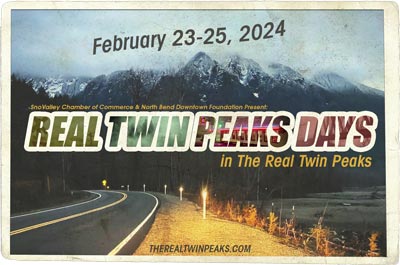First thread here. I notice in the location where the Gordon Cole and other officers arrive a strange kind of vegetation. Behind the house there is a tree similar to a palm. That's too weird even for TP standards (I think they shoot the whole scene around Los Angeles in California, to be honest).
Welcome aboard and congrats on your first thread! 🙂
It is entirely possibly and even likely that they filmed in LA and palms are certainly not indigenous to the Dakotas.
However, let's give it a think through. My neighbor a few houses down has some tropical looking palmy things in his yard. Definitely not native to the Seattle area, but he likes it and had it landscaped that way. They seem to be growing and reasonably healthy.
You can also see all sort "unusal" plants in different places purely because some human and not mother nature decided to put it there. The place in S. Dakota was some sort of defunct residence or business, perhaps even development that never got off the ground. However, somebody might have decide that the Dakotas needed a little tropic in their existence and planted palms or whatever they were. Who knows.
Or maybe it IS just a location/editing oversite.
Can you post a pic of what you are referring to?
Of course! I've captured a screenshot, the purported palm tree is the tree inside the red circle. It might be a Phoenix canariensis or Butia capitata or Jubaea chilensis, who knows? Anyway it looks a pinnate-leaved palm tree, which is hardy to about −12 °C/10 °F and tolerates only brief cold spells. These trees may have some problems in my Tuscan village full of olive trees, let alone South Dakota with an average January temperature of −12 °C/10 °F...
When I was attending university in Tucson, Az I had both a lemon tree and a grapefruit tree in my backyard. Also in the neighborhood were orange and olive trees. Not to mention, banana and oleander (the latter which killed giraffes at the local zoo. Nasty stuff, as I've trimmed and removed it).
Well, Tucson is much more warm than South Dakota. Another possibility is that that zone (the Zone?) is weirdness itself, so that peculiar tree might stand for "a place out of this world" in DKL's mind. (The tree on the right could also be an eucalyptus. But actually doesn't matter.)
I've seen palm trees in Michigan (oh the diversity). Such savage places!
I'll see you a eucalyptus tree and raise you a pepper tree (Tom awaits). So, yes, The Zone offers climatic weirdness but so too does the US in general.
I think the Zone climate weirdness in frosty South Dakota deserves a sign like this in the immediate neighborhood:
Hey Kyle,
I was wondering if anybody was else was ever going to mention that silly date palm; I noticed it immediately only because I knew beforehand that the Buckhorn locations were shot in Palmdale, CA (LA). Of course, leave it to a paisan to catch it (you're Italian, right?).
I'm a UW research botanist specializing in native species restoration in our Pacific NW Cascade temperate zone. I'm no expert on palm trees, for sure. I do know there are no (zero, zip) palm species native to any part of the continental US. All those growing happily in California have been naturalized; they are native to Central and South America.
Sadly, there is one species, trachycarpus fortunei, which is somewhat hardy as far north as Seattle where I live, and even as far up as Vancouver, BC, but still no native. They are a sad, adaptive, resentful lot, compared to their brethren living in their natural zone. Skinny, shivering, pathetic. I'm a purist. That's just wrong.
Hey Kyle,
I was wondering if anybody was else was ever going to mention that silly date palm; I noticed it immediately only because I knew beforehand that the Buckhorn locations were shot in Palmdale, CA (LA). Of course, leave it to a paisan to catch it (you're Italian, right?).
I'm a UW research botanist specializing in native species restoration in our Pacific NW Cascade temperate zone. I'm no expert on palm trees, for sure. I do know there are no (zero, zip) palm species native to any part of the continental US. All those growing happily in California have been naturalized; they are native to Central and South America.
Sadly, there is one species, trachycarpus fortunei, which is somewhat hardy as far north as Seattle where I live, and even as far up as Vancouver, BC, but still no native. They are a sad, adaptive, resentful lot, compared to their brethren living in their natural zone. Skinny, shivering, pathetic. I'm a purist. That's just wrong.
Hi, yes I'm Italian and in my zone (inner Tuscany) there are some Trachycarpus fortunei, Chamaerops humilis, Butia capitata and Phoenix canariensis in gardens. The first one is the hardest and needs no winter shelter; P. canariensis (Canary island date palm) might suffer in cold spells (we're 8b/9a USDA hardiness). I'm not a professional botanist, just interested in, here in Europe there are only two native species: C. humilis in coastal Mediterranean dunes and Phoenix theophrastii in Crete (very rare); as far as the continental United States are concerned, there are some species reported to be native of California (i.e. Washingtonia filifera) and Southern East coast (i.e. Sabal palmetto). Don't be sure whether they are really native or long-time naturalized. Cheers!
You could be absolutely right. Opinions vary all over the place. Research canon holds that the Washingtonias were native from Panama to Mexico and only naturalized after being brought to California, but there's variation in that research. I've also been told the Southern Palmettos were really only native to Colombia, and again, naturalized here but really who knows...like Twin Peaks.
I just stick with the firs and cedars. 😉
These are on US Hwy 12 just west of Aberdeen, South Dakota.






